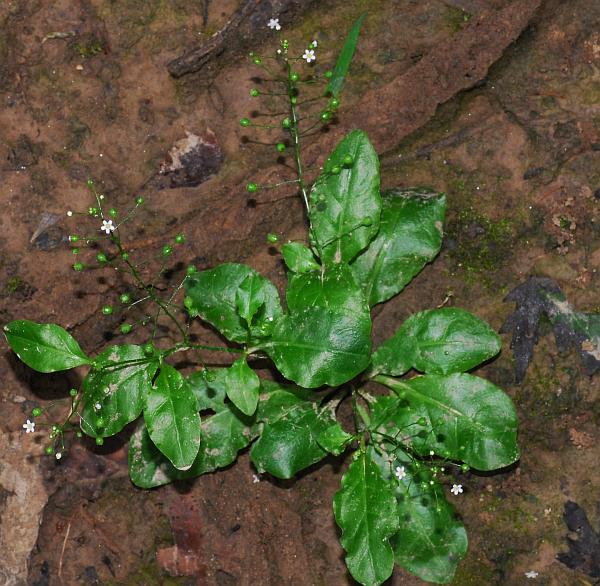Samolus parviflorus Raf.
Water Pimpernel

Native
CC = 5
CW = -5
MOC = 56
© SRTurner
Samolus parviflorus Raf.Water Pimpernel | |
 |
Native CC = 5 CW = -5 MOC = 56 |
© SRTurner |
|
Family - Primulaceae Habit - Perennial, slightly succulent forb with fibrous roots. Stems - Ascending, to 35 cm, multiple from base, usually branched, glabrous.
Leaves - Basal and alternate, petiolate. Leaf blades 2-9 cm long, oblanceolate to obovate, tapered at the base, rounded or broadly angled to a bluntly pointed tip, the margins entire, the surfaces glabrous and sometimes shiny.
Inflorescences - Terminal and/or axillary racemes, these sessile or short-stalked, the axis slender, flexuous, the flowers long-stalked, with a small bract near the midpoint. Axis and pedicels glabrous.
Flowers - Perigynous by fusion of the ovary to the calyx tube. Calyces 0.7-1.5 mm long, the tube 0.5-1.0 mm, fused to ovary, the lobes 0.2-0.5 mm long, broadly triangular, sharply pointed at the tips. Corollas 1.0-1.5 mm long, white, deeply 5-lobed, the lobes oblong rounded or notched at the tips. Stamens 5, attached in the corolla tube. Staminodes minute, slender, scalelike, positioned in the sinuses between the corolla lobes. Ovary 1/2-2/3 of the way inferior, the style minute, the stigma, minute, capitate.
Fruits - Capsules 2-3 mm long, globose, green, the walls translucent, dehiscent partway from the tip by 5 valves. Seeds minute, more or less triangular in outline, brown.
Flowering - April - September. Habitat - Streambanks, pond margins, seeps, sloughs, bottomland forests, and bases and ledges of bluffs, sometimes emergent aquatics in shallow water. Origin - Native to the U.S. Lookalikes - None. Other info. - This little species can be found in much of Missouri, excluding the northwestern third of the state. Its U.S. distribution is primarily southern. The flowers are quite small and overall the plant is fairly inconspicuous and easily missed. Once found it is relatively easy to recognize from its habitat, totally glabrous habit, tiny white flowers, and small round fruits on a zigzag stem. The plant makes its home in wet areas. It can grow underwater and is sometimes sold as an aquarium plant. Photographs taken on the banks of the Current River in Van Buren, MO., 6-16-01, and at the Mud Crek Conservation Area, Butler County, MO., 6-11-04 (DETenaglia); also at Busch Wildlife Area, St. Charles County, MO, 6-19-2013, Young Conservation Area, Jefferson County, MO, 7-31-2013, Tyson County Park, St. Louis County, MO, 8-31-2018, and Big Cane Conservation Area, Butler County, MO, 6-9-2023 (SRTurner). |